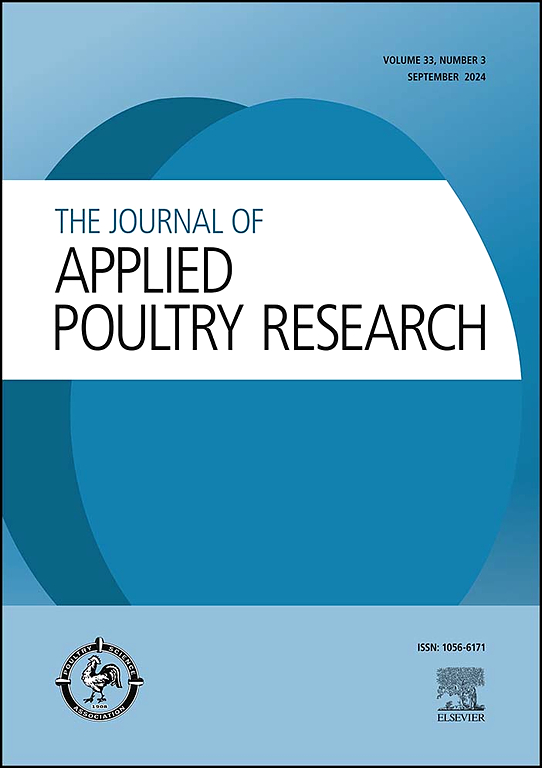Formaldehyde and propionic acid do not reduce starch gelatinization within a laboratory setting and may not contribute to reduced pellet quality
IF 2
3区 农林科学
Q2 AGRICULTURE, DAIRY & ANIMAL SCIENCE
引用次数: 0
Abstract
Starch gelatinization acts as a pellet binder, and thereby, increase pellet quality. Increasing pellet quality has been shown to improve bird performance. The use of antimicrobial feed additives has been increasing due to the risk of salmonellosis to consumers. A previous experiment included an antimicrobial primarily composed of formaldehyde and propionic acid added at the mixer to poultry feed. The study steam conditioned the feed for a shorter duration compared to a longer duration and discovered a decrease in pellet quality. We hypothesize that the product inhibited starch gelatinization and that the degree of inhibition is based on heating time. Therefore, the objective of this experiment was to determine the effect of formaldehyde and propionic acid on starch gelatinization via glucose release and spectrophotometry across two heating times. Corn starch suspensions were heated at 82°C for 2 min 30 sec or 15 min and added to base reagents. Formaldehyde and/or propionic acid were added to the appropriate corn starch suspensions prior to heating, while the control lacked either of the chemicals. The absorbance of the 4 formulations at each heating time were measured using spectrophotometry (Beckman Coulter, DU 530, Brea, CA). Three replications were performed per treatment. All 4 formulations were analyzed using a multiple comparison. A two-way ANOVA was also employed to explore the 4 (formulation) × 2 (heating time) factorial arrangement of treatments. There was a heating time × formulation interaction where all formulations heated for 15 min had a significant increase in gelatinization relative to the 2.5 min formulations, with the control formulation showing the least amount of change (P < 0.05). Formaldehyde and propionic acid did not reduce starch gelatinization regardless of heating time. The increase in starch gelatinization with increased heating time may translate to increasing pellet quality.
在实验室环境中,甲醛和丙酸不会降低淀粉糊化,也不会降低颗粒质量
淀粉糊化作为球团粘合剂,从而提高球团质量。提高颗粒质量已被证明可以提高鸟类的性能。由于消费者面临沙门氏菌病的风险,抗菌饲料添加剂的使用一直在增加。先前的实验包括一种主要由甲醛和丙酸组成的抗菌剂,通过混合器添加到家禽饲料中。该研究对饲料进行蒸汽调节的时间较短,而对饲料进行蒸汽调节的时间较长,结果发现颗粒质量下降。我们假设该产品抑制淀粉糊化,抑制程度取决于加热时间。因此,本实验的目的是通过葡萄糖释放和分光光度法在两个加热时间内确定甲醛和丙酸对淀粉糊化的影响。玉米淀粉悬浮液在82℃下加热2分钟30秒或15分钟,加入基础试剂。在加热前,在适当的玉米淀粉悬浮液中加入甲醛和/或丙酸,而对照组不添加这两种化学物质。使用分光光度法测量4种配方在每次加热时间的吸光度(Beckman Coulter, DU 530, Brea, CA)。每次治疗进行3次重复。采用多重比较对所有4种制剂进行分析。采用双向方差分析探讨4(配方)× 2(加热时间)治疗的因子排列。存在加热时间×配方的相互作用,其中所有加热15分钟的配方相对于加热2.5分钟的配方,糊化率显著增加,对照配方的变化最小(P <;0.05)。无论加热时间如何,甲醛和丙酸都没有降低淀粉的糊化。随着加热时间的延长,淀粉糊化的增加可能转化为颗粒质量的提高。
本文章由计算机程序翻译,如有差异,请以英文原文为准。
求助全文
约1分钟内获得全文
求助全文
来源期刊

Journal of Applied Poultry Research
农林科学-奶制品与动物科学
CiteScore
4.10
自引率
10.50%
发文量
80
审稿时长
104 days
期刊介绍:
The Journal of Applied Poultry Research (JAPR) publishes original research reports, field reports, and reviews on breeding, hatching, health and disease, layer management, meat bird processing and products, meat bird management, microbiology, food safety, nutrition, environment, sanitation, welfare, and economics. As of January 2020, JAPR will become an Open Access journal with no subscription charges, meaning authors who publish here can make their research immediately, permanently, and freely accessible worldwide while retaining copyright to their work. Papers submitted for publication after October 1, 2019 will be published as Open Access papers.
The readers of JAPR are in education, extension, industry, and government, including research, teaching, administration, veterinary medicine, management, production, quality assurance, product development, and technical services. Nutritionists, breeder flock supervisors, production managers, microbiologists, laboratory personnel, food safety and sanitation managers, poultry processing managers, feed manufacturers, and egg producers use JAPR to keep up with current applied poultry research.
 求助内容:
求助内容: 应助结果提醒方式:
应助结果提醒方式:


